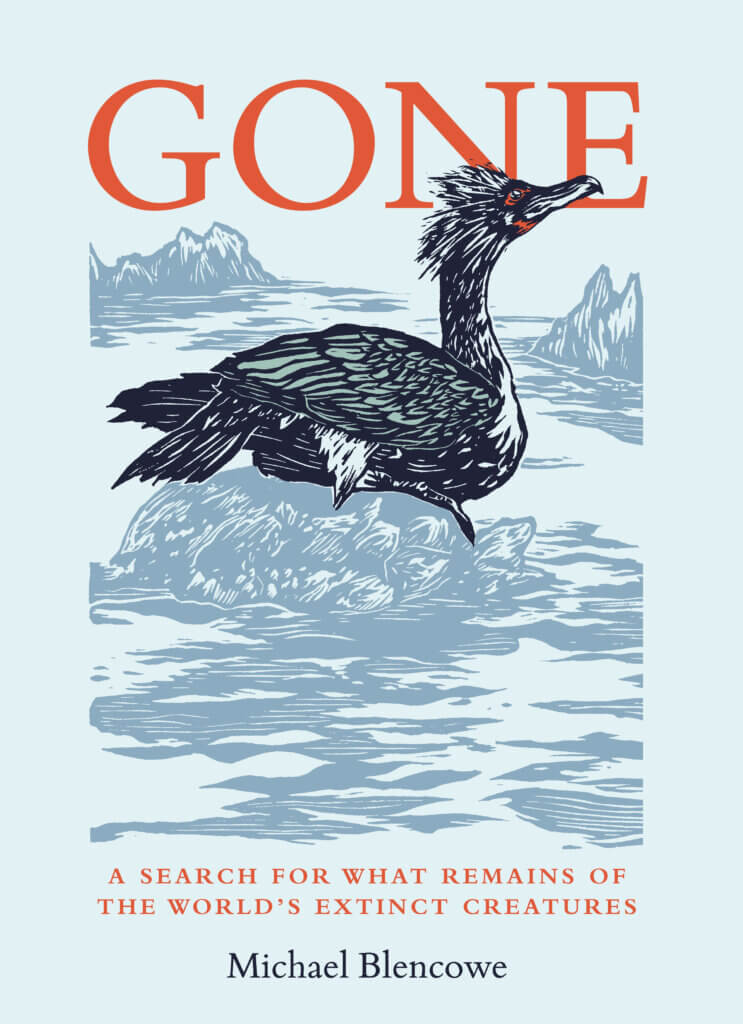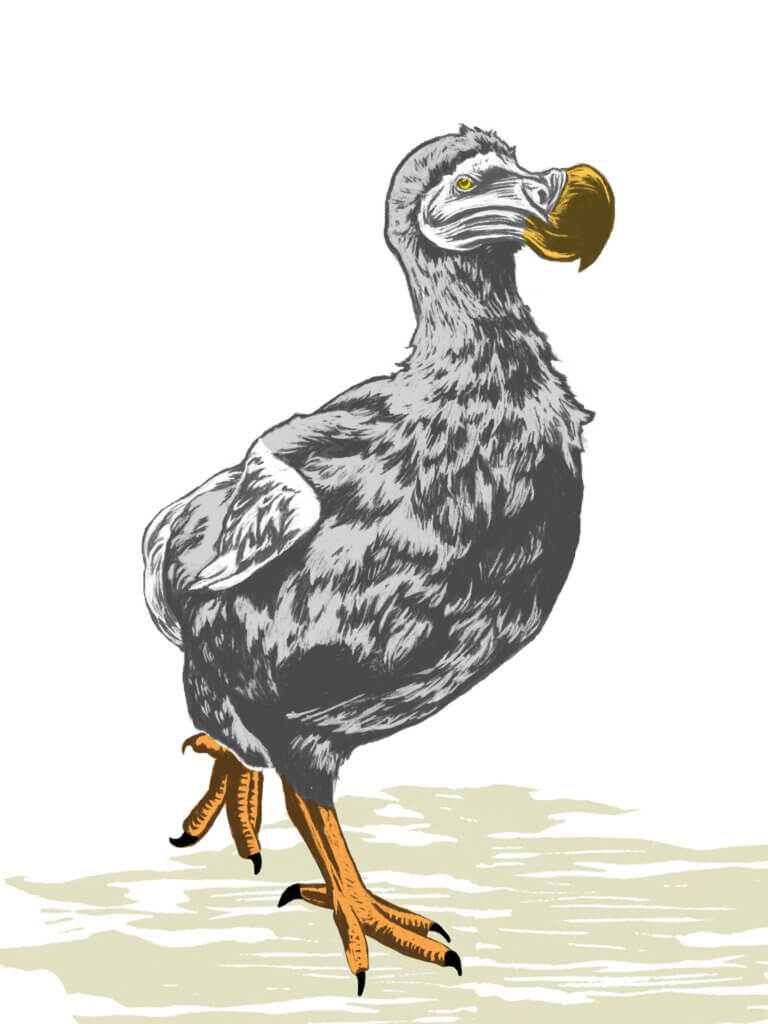
This is a book about extinct animals – I’m personally interested in extinctions and so I thought I might enjoy this book, but, obviously it would depend on the way the author handled the subject and the quality of the writing. I did enjoy this book.
Eleven species are given their own chapters; two mammals (Steller’s Sea Cow and Schomburgk’s Deer), six birds (Great Auk, Spectacled Cormorant, Upland Moa, Huia, South Island Kokako and Dodo), a reptile (Pinta Island Tortoise) an insect (Xerces Blue) and the Ivell’s Sea Anemone. This is clearly not a pro rata treatment of extinct species (no plants, few invertebrates) but is closer to an accurate reflection of where the most information lies and where the best stories can be told. And Michael Blencowe is an excellent story-teller. Each chapter is a good read and the author unearths interesting information about the species, the places where they lived and the characters involved in trying to conserve them or propelling them into the abyss of extinction.

There are challenges writing about extinct species – you cannot go and see them and then wax lyrical about their behaviour and the beauty of, or threats to, the places where they live. All that is in the past. Blencowe visits many places where these species used to live but also the museums where they are interred. I’m glad he visited San Francisco to pay homage to the Xerces Blue butterfly (as I have done – see here and A Message from Martha p180) but he didn’t get to Mauritius but instead hunted down Dodo stories in Battle, from Vauxhall Bridge and in Oxford. This added an unpredictability to the chapters – are we going to New Zealand or to a dusty museum in central Europe instead? Well, read the book and find out. Wherever Blencowe takes us he has a good tale to tell.
You don’t have to be interested in extinction to enjoy this book, as each chapter has its own narrative of people and places which stands alone. There is no attempt at synthesis across the species and the book simply ends with the author floating in a lagoon in Sussex (as one does). That’s fine. But reading these accounts one can’t escape reflecting on what a sorry tale these extinctions exemplify. After all, they are just the worst case scenarios of wildlife loss occurring right across the globe. I confess to being drawn to an analogy with recent UK government cabinets – a mixture of uncaring greed and ignorant bungling in which the good intentions sank without impact.
The cover and text illustrations are by Jade They – quite nice. A one-word book title is quite classy, a 10-word subtitle, less so.
This is a very good read and a successful model which could be repeated – unfortunately there are plenty of extinct species left about which to write. If Michael Blencowe is to extinction what Liam Neeson is to kidnap rescue films, then I’d be keen to read Gone 2 and Gone 3.
Gone: a search for what remains of the world’s extinct creatures by Michael Blencowe is published by Leaping Hare Press (on 27 April).
[registration_form]
This looks brilliant, if there are extinct species then we should at least know about them so in a way they’re not rendered into total oblivion, not just killed off by humanity, but completely forgotten too. It seems a bit hit and miss what species are remembered – fantastic to see the spectacled cormorant getting attention here alongside the more famous great auk, I was fifteen before I first heard about the cormorant which was quite shocking given how fascinated by extinct animals I’d been for about eight years by then. Along with the dodo there was a very unusual and very large species of parrot lost on Mauritius. It’s also been discovered that dodo doo doo had its own specialist dung beetle, now lost as well obviously. Then only three years ago bones of an extinct gibbon species were found (hinting at the cause of its loss) in an ancient Chinese tomb. It was so distinctive it looks like it is in a new genus https://www.nytimes.com/2018/06/21/science/extinct-gibbon-china.html . Is it just me or should a piece of news like that be a big enough deal to get reported comprehensively on mainstream media?
This book looks like it’s making an effort to bring some of the more obscure species into the daylight again which is wonderful and a process that needs to continue. It’s easy to see why the woolly mammoth gets such attention, but in comparison the elasmotherium, an enormous single horned rhino which might just be the source of the unicorn legend, hardly gets any, although its relative the woolly rhino fares a little better. I’ve been reading every dam thing I could on prehistoric extinctions since the mid seventies, and yet it was only in the last year I found out about Cervalces latifrons a deer that was even larger than the Irish elk, but its antlers weren’t quite so impressive so it doesn’t even have an English name, but people almost certainly knew of and ended its existence.
We really need to do a better job of getting the public to know just how horrendous the loss of many likely keystone species has been along with equally fascinating species dependent upon them. Two genera of passerines that probably acted like ox peckers died out in north America along with the mammoth, western camel and ground sloths. It’s the same story with the loss of megafauna in Australia. Some plants clearly had their fruit and seeds distributed by these big beasts, they’ve hung on, but are not as widespread or ecologically important as they once were. Much of our landscape is really a ghostscape, empty of many of its players.
I’ve always wanted to do a ‘Fantasy Bird Table’ exhibit for festivals and events. You’d have bits and pieces to mock up a fairly typical garden – fence, lawn, small tree, pond and of course bird table. The fantasy part is that you’d put models in it of birds that not only would it be a miracle that they’d be in your garden because they’re (with one exception) foreign species, but also because they are or almost certainly are extinct. So there’d be ivory billed and imperial woodpeckers having a go at the tree trunk, a passenger pigeon and Carolina parakeet on the bird table joined by a Mauritius blue pigeon, Bachman’s warbler and a couple species of lost hummingbirds dipping into a sugar feeder hanging from it. On the mock up lawn you could have a bewildered Eskimo curlew probing away, a snail eating coua from Madagascar keeping it company, a Rodrigues solitaire and one or more of a kindred rail and pigeon species we’ve lost looking for grubs and spilt bird seed. The pond could end up being really overcrowded – great auk and spectacled cormorant, Korean crested shelduck, pink headed and Labrador ducks, Auckland island merganser, Atitlan Grebe…….I think seeing these birds represented in an everyday, but still fantastical, situation might make it easier for people to identify with their loss than if they were presented in the standard museum case way. The ‘fun’ part of the exhibit would ironically underline the sadness – we have as much chance seeing them in our gardens as anywhere else. Got to be worth a try, how many British people even know about the great auk?
Think you might be on to something there Les.